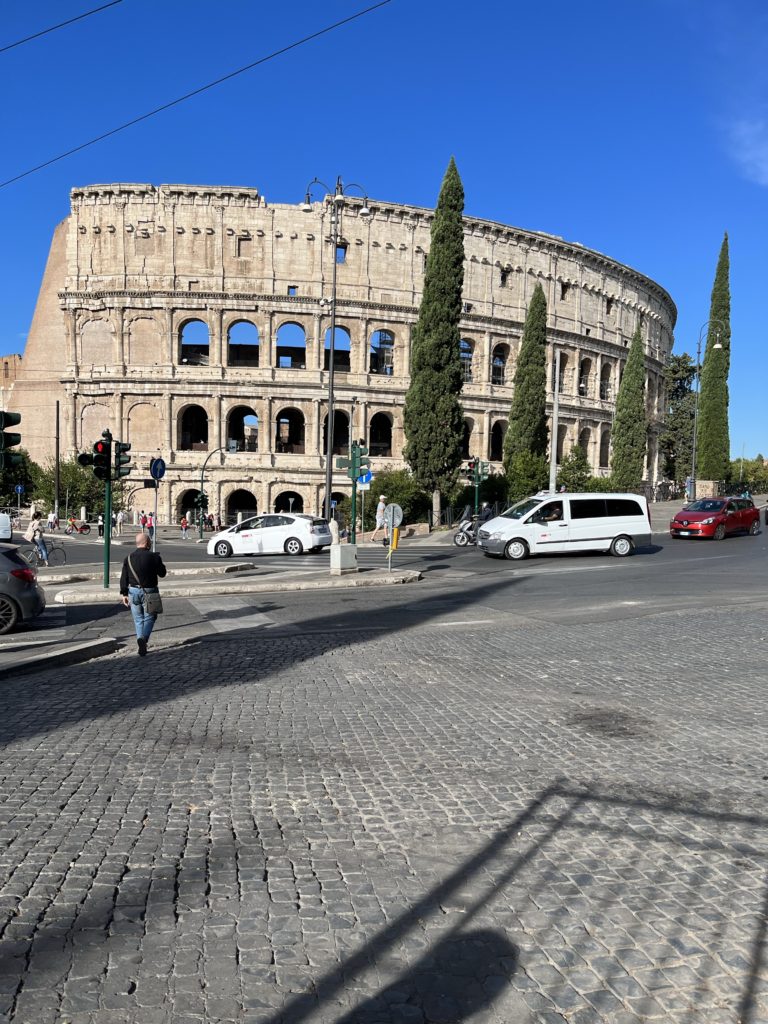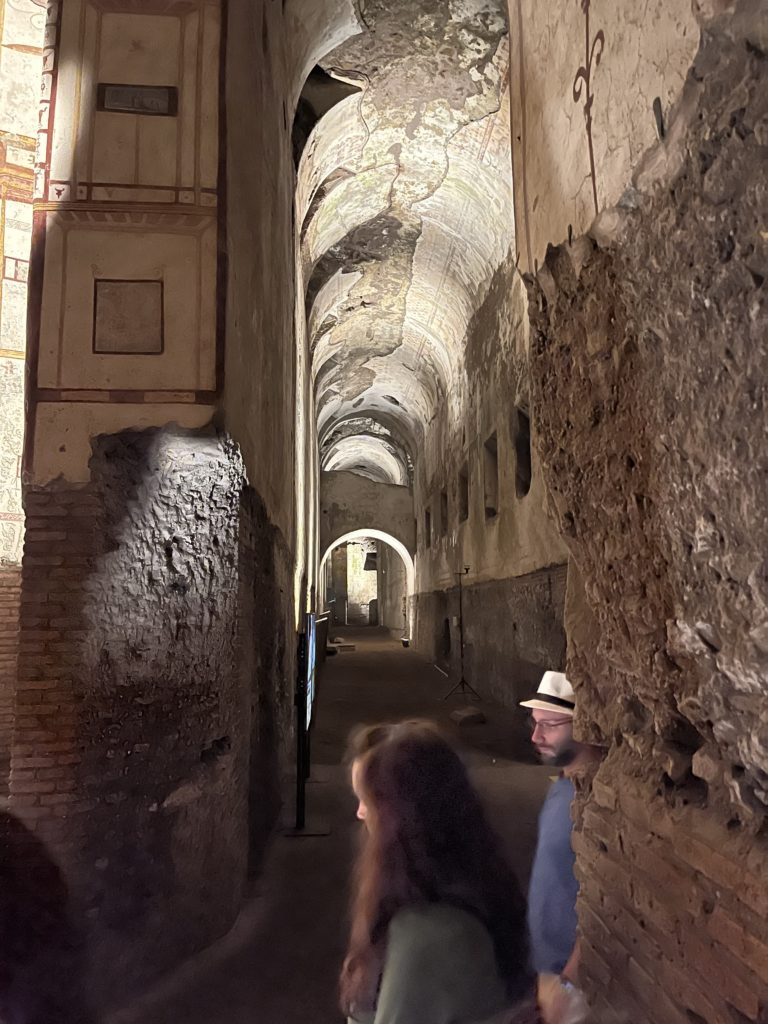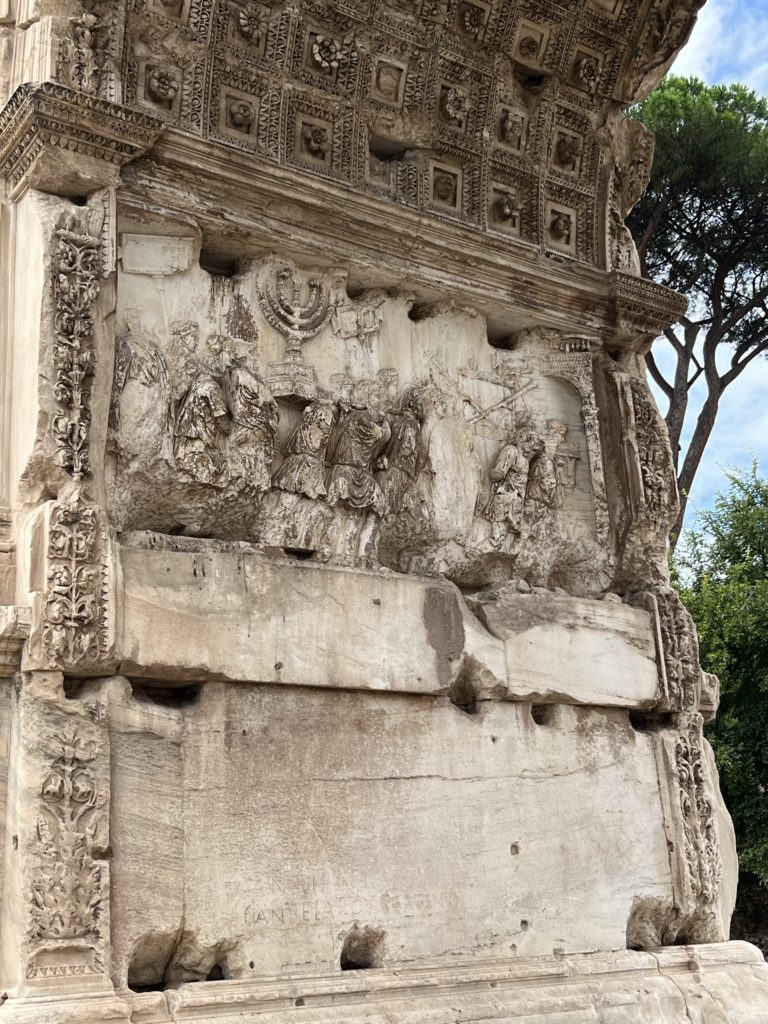
At 9:15 a.m. we were back at the entrance to the Domus Aurea, and this time there was a tour guide waiting for us. The Domus Aurea (“Golden House”) was the ostentatious palace of Emperor Nero-three of its wings covered 125 acres–for those of you keeping score, that is nearly 5.5 million square feet. The Domus Aurea was an extension of Nero’s original palace, the Domus Transitoria.
There is a good argument for the proposition that Nero was “the beast” John wrote about in the book of Revelation. “Neron Caesar” transliterated from Greek into the Hebrew short-form spelling, נרון קסר, produces the number 666. See Revelation 13:18. Nero instituted a horrible persecution against Christians following the great fire of Rome in 64 A.D., falsely blaming Christians for the fire. Nero also murdered his own mother and first wife.
Nero, according to contemporaneous Roman historian Tacitus, had Christians “killed by dogs by having the hides of beasts attached to them, or they were nailed to crosses or set aflame, and, when the daylight passed away, they were used as nighttime lamps.” Tacitus writes that “Nero gave his own gardens for this spectacle . . .” And Nero did that here, where we were this morning.

The tour through the now underground halls of the Domus Aurea is fascinating and is enhanced by a virtual reality experience that brings it all to life, but ultimately the Domus Aurea was a a monument to the vanity and wickedness of one man.
God’s judgment is not always swift but always certain. The Roman Senate eventually turned on Nero, and Nero committed suicide before he could be executed. Emperor Trajan subsequently filled in and covered over the Domus Aurea with dirt, using it as a foundation for a public bath.
That same Trajan (emperor 98 A.D. to 117 A.D.) on a campaign to battle the Parthians, stopped in Antioch in 115 A.D. There, Ignatius, Bishop of Antioch, was brought before Trajan and accused of being a Christian. Ignatius was a disciple of the Apostle John.
Ignatius engaged in a courageous debate with Trajan in Antioch and demonstrated his allegiance to Jesus. As a result, Trajan had Ignatius sent to Rome where he was thrown to the beasts in the Colosseum and became a martyr for King Jesus.
The Colosseum was our second stop of the day. It is a marvelous, iconic structure, but for Kingdom citizens, it is the field where the blood of martyrs was spilled to become, as Tertullian (160 A.D. – 220 A.D.) said, “the seed of the Church.” Incidentally, Trajan never made it back to Rome from Antioch; he died of a stroke in 117 A.D.
The Colosseum was completed in 80 A.D. by Emperor Titus. Titus is interesting because through him Jesus fulfilled His prophecy that before the generation would pass away, not one stone of the Temple in Jerusalem would be left upon another. See Matthew 24:2. In 70 A.D. Titus sacked Jerusalem, destroyed the temple, and carried off its treasures. After the Colosseum today we saw the Arch of Titus, with the famous relief showing the Roman Soldiers carrying away the treasures of the temple.

We also saw the magnificent Basilica of Maxentius and Constantine, so named because it was started by Maxentius and finished by Constantine after Maxentius was defeated at the Battle of the Milvian bridge, commemorated on the Arch of Constantine, which we also saw this morning.
I will not spend time describing our other stops today: the place the ashes of Julius Caesar were kept on the Forum; or the Roman Senate building; or the palace of Caesar Augustus and Livia (and other Julio-Claudian Emperors) overlooking the Forum; or the bronze statute of Marcus Aurelius at the Capitoline Museum. They were all bit players in the unfolding epic that is the kingdom of God. The stars are the Apostle Peter, Paul of Tarsus, the Christians martyred in Nero’s back yard, Ignatius of Antioch, Constantine the Great, and all the others who have sought first the kingdom of God, even at the risk of their own lives. GS
